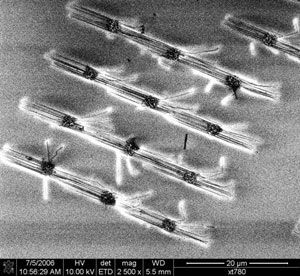Home > Press > Breakthrough toward industrial-scale production of nanodevices
 |
| Researchers in Maryland report an advance toward making zinc oxide nanowires (shown) on an industrial scale. Courtesy of Babak Nikoobakht, National Institute of Standards and Technology |
Abstract:
Scientists in Maryland are reporting an important advance toward the long-sought goal of industrial-scale fabrication of nanowire-based devices like ultra-sensitive sensors, light emitting diodes, and transistors for inexpensive, high-performance electronics products. The study is scheduled for the current issue of ACS' Chemistry of Materials, a bi-weekly journal.
Breakthrough toward industrial-scale production of nanodevices
Gaithersburg, MD | Posted on November 7th, 2007In the report, Babak Nikoobakht points out that existing state-of-the-art assembly methods for nanowire-based devices require complicated, multi-step treatments, painstaking alignments steps, and other processing for nanowires , which are thousands of times smaller than the diameter of a human hair. The goal is to electrically address the coordinates of millions of nanowires on a surface in order to produce the components of electronic circuits.
The study describes a new method in which zinc oxide nanowires are grown in the exact positions where nanodevices later will be fabricated, in a way that involves a minimum number of fabrication steps and is suitable for industrial-scale applications. "This method, due to its scalability and ease of device fabrication, goes beyond the current state-of-the-art assembly of nanowire-based devices," the report states. "It is believed to be an attractive approach for mass fabrication of nanowire-based transistors and sensors and is expected to impact nanotechnology in fabrication of nonconventional nanodevices."
####
About American Chemical Society
The American Chemical Society — the world's largest scientific society — is a nonprofit organization chartered by the U.S. Congress and a global leader in providing access to chemistry-related research through its multiple databases, peer-reviewed journals and scientific conferences. Its main offices are in Washington, D.C., and Columbus, Ohio.
For more information, please click here
Contacts:
Babak Nikoobakht, Ph.D.
National Institute of Standards and Technology
Gaithersburg, Maryland 20899
Phone: 301-975-3230
Fax: 301- 926-6689
Email:
Copyright © American Chemical Society
If you have a comment, please Contact us.Issuers of news releases, not 7th Wave, Inc. or Nanotechnology Now, are solely responsible for the accuracy of the content.
| Related Links |
| Related News Press |
Chip Technology
![]() Lab to industry: InSe wafer-scale breakthrough for future electronics August 8th, 2025
Lab to industry: InSe wafer-scale breakthrough for future electronics August 8th, 2025
![]() A 1960s idea inspires NBI researchers to study hitherto inaccessible quantum states June 6th, 2025
A 1960s idea inspires NBI researchers to study hitherto inaccessible quantum states June 6th, 2025
![]() Programmable electron-induced color router array May 14th, 2025
Programmable electron-induced color router array May 14th, 2025
Nanoelectronics
![]() Lab to industry: InSe wafer-scale breakthrough for future electronics August 8th, 2025
Lab to industry: InSe wafer-scale breakthrough for future electronics August 8th, 2025
![]() Interdisciplinary: Rice team tackles the future of semiconductors Multiferroics could be the key to ultralow-energy computing October 6th, 2023
Interdisciplinary: Rice team tackles the future of semiconductors Multiferroics could be the key to ultralow-energy computing October 6th, 2023
![]() Key element for a scalable quantum computer: Physicists from Forschungszentrum Jülich and RWTH Aachen University demonstrate electron transport on a quantum chip September 23rd, 2022
Key element for a scalable quantum computer: Physicists from Forschungszentrum Jülich and RWTH Aachen University demonstrate electron transport on a quantum chip September 23rd, 2022
![]() Reduced power consumption in semiconductor devices September 23rd, 2022
Reduced power consumption in semiconductor devices September 23rd, 2022
Discoveries
![]() Researchers develop molecular qubits that communicate at telecom frequencies October 3rd, 2025
Researchers develop molecular qubits that communicate at telecom frequencies October 3rd, 2025
![]() Next-generation quantum communication October 3rd, 2025
Next-generation quantum communication October 3rd, 2025
![]() "Nanoreactor" cage uses visible light for catalytic and ultra-selective cross-cycloadditions October 3rd, 2025
"Nanoreactor" cage uses visible light for catalytic and ultra-selective cross-cycloadditions October 3rd, 2025
Announcements
![]() Rice membrane extracts lithium from brines with greater speed, less waste October 3rd, 2025
Rice membrane extracts lithium from brines with greater speed, less waste October 3rd, 2025
![]() Researchers develop molecular qubits that communicate at telecom frequencies October 3rd, 2025
Researchers develop molecular qubits that communicate at telecom frequencies October 3rd, 2025
![]() Next-generation quantum communication October 3rd, 2025
Next-generation quantum communication October 3rd, 2025
![]() "Nanoreactor" cage uses visible light for catalytic and ultra-selective cross-cycloadditions October 3rd, 2025
"Nanoreactor" cage uses visible light for catalytic and ultra-selective cross-cycloadditions October 3rd, 2025
|
|
||
|
|
||
| The latest news from around the world, FREE | ||
|
|
||
|
|
||
| Premium Products | ||
|
|
||
|
Only the news you want to read!
Learn More |
||
|
|
||
|
Full-service, expert consulting
Learn More |
||
|
|
||








